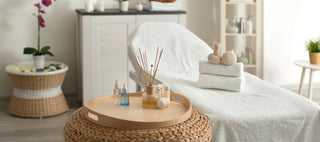Understanding Massage Table Positions
Massage tables are designed to accommodate various client needs, and understanding their positions is essential to effective treatments. If you’ve ever wondered, “Do massage tables sit up?” the answer lies in their modern designs and adjustable features. From traditional flat surfaces to advanced sit-up functionality, these positions allow for targeted therapies and improved comfort. In this guide, we'll explore how different positions improve the massage experience and help you decide which options suit your practise.

Traditional Table Positions:
Massage tables have three primary positions that cater to different therapeutic needs and client preferences. These foundational positions form the basis of most treatments, ensuring clients feel supported while therapists perform their work.
- Prone position: Face down
In this position, clients lie on their stomachs. It’s particularly useful for accessing the back, shoulders, and posterior leg muscles. Therapists often use this position for deep tissue and Swedish massages, offering a secure and effective setup.
- Supine position: Face up
Clients lie on their backs, allowing therapists to work on the front of the body. This position is ideal for treatments focusing on the chest, abdomen, and anterior leg muscles. It’s a common choice for relaxing and restorative massages.
- Side-lying position: On the side
Side-lying positions are perfect for clients who find lying flat uncomfortable, such as pregnant individuals or those with specific medical conditions. This position also facilitates access to certain muscle groups without causing unnecessary strain.

Sit-Up Functionality:
Sit-up massage tables add a modern twist to traditional designs. These tables feature adjustable sections that allow clients to sit upright or recline at various angles. They are particularly beneficial for treatments that require a semi-reclined posture, such as facials, reflexology, or seated acupuncture. Additionally, they provide a solution for clients who experience respiratory issues or back discomfort when lying flat. The sit-up functionality improves versatility, making these tables a practical choice for both therapists and clients.
Benefits of Sit-Up Massage Tables
Sit-up massage tables offer numerous advantages, improving the experience for clients and therapists alike. Their flexibility and ergonomic design make them suitable for a variety of therapeutic applications.
Ideal Therapist Access:
Having a sit-up feature makes it easier for therapists to access certain areas of the body. For larger or taller clients, this functionality ensures that the therapist can reach target areas without compromising their posture. This ergonomic advantage reduces physical strain during long sessions, helping therapists maintain their energy and focus.
Improved Client Comfort:
Some clients may feel discomfort lying flat for extended periods. Sit-up tables address this by offering a supportive and adjustable setup. Clients with respiratory concerns, back pain, or mobility issues can enjoy a more tailored experience that prioritises their well-being.
Versatility for Different Therapies:
Sit-up massage tables accommodate a wider range of treatments. From reflexology and facials to seated acupuncture and beauty therapy, these tables adapt to the needs of various practices. This versatility benefits therapists who offer diverse services and need equipment that matches their skill set.

Considerations for Choosing a Sit-Up Massage Table
Selecting the right sit-up massage table requires a careful balance between practicality and client comfort. It’s important to think about how the table will fit into your practice—whether you work from a fixed location or provide mobile services. A sit-up table should meet the demands of your daily sessions without compromising the experience you provide to clients.
When choosing, consider the types of treatments you offer and the preferences of your clients. For example, some clients may benefit from a table with more advanced adjustability options, while others may prioritise comfort features like extra padding. A good table supports your work style and helps you create a welcoming, professional environment.
Weight Capacity:
The weight capacity of a massage table determines its ability to accommodate clients of different sizes. Professional-grade tables are designed to handle varying weights without compromising stability, making them suitable for a diverse client base.
Adjustability:
The range of angles and positions a table offers significantly impacts its usefulness. Tables with smooth, reliable adjustment mechanisms—like hydraulic or electric systems—allow for quick changes during sessions, ensuring seamless transitions for clients.
Comfort and Durability:
High-quality padding and durable upholstery are key to client comfort. Tables with thick, supportive foam and easy-to-clean materials are ideal for maintaining a professional and welcoming environment. Durability is also important for long-term use, especially in busy practices.
Portability:
For mobile therapists, lightweight tables with foldable frames are a practical option. These models are designed for easy transport and setup while still offering the stability required for effective treatments.
Additional Tips:
- Use proper body mechanics: Position yourself to minimise strain and maintain control during treatments.
- Communicate with your client: Discuss how the sit-up position can address their specific needs or concerns.
- Provide adequate support: Use pillows or bolsters to maintain alignment and improve comfort.

Conclusion
Massage tables with sit-up functionality answer the question, “Do massage tables sit up?” with a resounding yes. These versatile tools provide improved comfort and accessibility for clients while making life easier for therapists. By considering factors like weight capacity, adjustability, and portability, you can select a table that suits your practice and improves your service offerings. Sit-up massage tables support a wide range of therapies and can optimise the overall client experience. Choosing a high-quality table is a practical way to provide effective and professional treatments.
Improve your massage experience now with ease! Browse Natural Living’s high-quality massage tables here.
Related Blogs:
- Why Choose a Portable Massage Table with Adjustable Height?
- Make Your Massage Table More Comfortable: Tips & Tricks
- 5 Features to Consider When Purchasing a Portable Massage Table
- Top 10 High Quality Massage Beds for Sale at Natural Living
- Choosing the Ideal Massage Bed for Your Practice: Key Considerations










